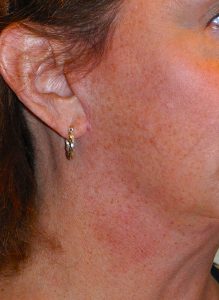The incisional access for much of facelift surgery is done in and around the ears. This access provides a method to undermine extended skin flaps across the face down along the jawline and int the neck. With this exposure different methods of SMAS elevate. can be done which allows a skin pullback and redrawing around the ears. With these maneuvers done along the semi-mobile segments of the ear, particularly the earlobe, there is always the risk of deformation of segments of the ear as it heals due to scar contraction. Such incisional healing around the ears is often the most visible part of facelift surgery so the scars, the shape of the ears and any alterations of the hairline are fairly visible.
In the August 2021 issue of the American Journal of Cosmetic Surgery an article was published on this topic entitled ‘The Effect of Extended SMAS Face-lift on Earlobe Ptosis and Pseudoptosis’. In this paper the authors evaluated the changes in the earlobe after an extended SMAS facelift. Their specific intent was to determine the effects of cheek and jawline/neck skin tension on postoperative earlobe shape based on the amount of excised skin that redraped up over the ear with skin flap repositioning. Over a three year period looking at thirty-four patients their photographs were evaluated for before and after surgery measurements of the cephalic (I-O distance) and caudal (O-S) ear segment heights. The effects of the amount of cheek skin and neck skin excision lengths were determined by comparing the changes to the cephalic and caudal ear segments.
Their results shows that the postoperative attached cephalic ear segment increased. (13mms preop vs almost 16mms postop) The postoperative free caudal ear segment decreased. (5.5mms preop vs 3.6mms postop) The excised superior skin median was found to be 3.0 cm and the lower skin excision median was found to be 3.5 cm. The caudal ear height increased by 3.85 mm for superior skin excisions ?3.0 cm compared with only 1.57 mm for superior skin excisions >3.0 cm. The caudal ear segment height decreased by 2.79 mm for skin excisions ?3.0 cm compared with only a decrease of 0.14 mm for skin excisions >3.0 cm.
Their data showed that that more aggressive cheek skin excisions (>3.0 cm) resulted in a decreased free caudal segment of the earlobe. More aggressive excisions of the cheek demonstrate a protective effect on preserving the free earlobe caudal segment, whereas more aggressive neck skin excisions result in higher propensity for loss of the free earlobe caudal segment.

What this study really shows is that there is a relationship between skin excision where it is located along the ear, how much is excised and how it can affect the shape of the ear. The earlobe is the most sensitive to shape malformations from facelifts because it has no cartilage support unlike the rest of the ear. But as this study shows if the maximum skin excision is located more towards the cephalic ear segment where it is better supports there is less risk of earlobe elongation.
Dr. Barry Eppley
Indianapolis, Indiana



